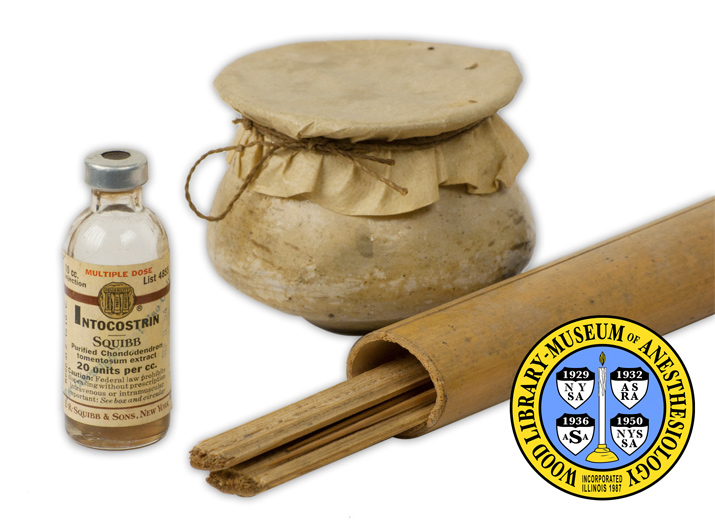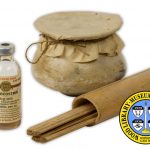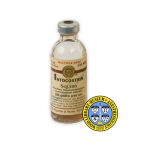Curare
The objects pictured, from left to right, are a vial of Intoconstrin (the first standardized commercial preparation of curare for medical use), a pot for distilled curare and a quiver of blow-gun darts, both of the kind made and used in by indigenous peoples of the Ecuadorian and Peruvian Amazon. Curare is a chemical found in certain South American vines. South American indigenous peoples discovered its ability to paralyze muscles, and prepared it to use for hunting. Curare was stored in pots; and hunters dipped their arrows or darts into the carefully made extract so that when they pierced an animal it became paralyzed.
By the 20th Century, Western physicians had long recognized the potential benefits of curare as a muscle relaxant. But a variety of factors delayed its development as a medication that doctors could easily obtain and use. In the late 1930s a determined American adventurer, Richard C. Gill (1901-1958), organized and led an expedition to South America to collect raw plant material, distill curare, and supply it to pharmaceutical companies. This was pivotal to the development of the class of agents known as neuromuscular blocking drugs (NMBD) commonly called ‘muscle relaxants’. First used clinically in 1942, muscle relaxants opened the door for profound advancements in anesthesia and surgery. They keep the body still during surgery and are especially necessary for delicate operations.
Catalog Record: Curare
Two Catalog Records (aiui, aiuj):
Access Key: aiui
Accession No.: 2011-01-21-2
Title: [Quiver of curare blow-gun darts.]
Publisher: [1938-1949.]
Physical Description: 1 quiver with darts and pith : bamboo ; 36 x 3 x 2.5 cm.
Subject: Curare.
Subject: Neuromuscular Nondepolarizing Agents.
Subject: Muscle Relaxants.
Subject: Gill, Richard Cochran, 1901-1958.
Note Type: General
Notes: Title from the WLM name for the object.
Note Type: Citation
Notes: Humble RM. The Gill-Merrill expedition: penultimate chapter in the curare
story. Anesthesiology. 1982;57(6):519-526.
Note Type: Citation
Notes: Larson M. Arthur E. Guedel Memorial Anesthesia Center: Richard C. Gill and
the introduction of curare into anesthesia practice. CSA Bulletin.
2003;52(3):47-51.
Note Type: Physical Description
Notes: A bamboo quiver with bamboo darts and pith; The quiver alone measures approx.
28.5 x 3 x 2.5 cm; A crack runs the length of one side of the quiver; One of
the bamboo piths measures approx. 31 x 1.5 x .5 cm; The second pith measures
31 x 2 x .5 cm; There are 4 sharpened darts approx 30.5 to 31 cm in length,
and approx. .3 x .4 cm at the widest point.
Note Type: Reproduction
Notes: Photographed by Mr. William Lyle, Sept. 2010.
Note Type: Acquisition
Notes: Donated to the WLM by the Gill Family, in 1958.
Note Type: Historical
Notes: The story of the development of neuromuscular blocking agents, commonly
called muscle relaxants, follows a long, circuitous path and involves such an
array of remarkable characters that it is often referred to as epic. The
story begins with curare, a chemical found within certain South American
plants. South American indigenous peoples discovered its ability to paralyze
muscles, and developed a way to prepare it for hunting. The process involved
among other things, continuously boiling the ingredients for several days
(Humble, 1982). Once the brew was reduced to a dark brown or black substance
it was poured into a container, generally either a pot made from a gourd or a
tube of bamboo. Hunters dipped their arrows or darts into the carefully made
substance so that when an arrow pierced an animal the animal became paralyzed
The quiver and arrows described here are of the kind made and used by
indigenous peoples of the Ecuadorian and Peruvian Amazon. They were once
personal possessions of Richard C. Gill, a pivotal character in the story of
curare and the development of the neuromuscular blocking agents that opened
the door for profound advancements in anesthesia and surgery.
Note Type: Historical
Notes: Richard C. Gill was a determined and talented adventurer who, with his
equally audacious wife, Ruth, conquered obstacles that deterred many others.
Richard Gill planned and led a treacherous expedition to a remote base camp
in the Ecuadorian Amazon. There he and his wife, with the assistance of
numerous local people, spent four months collecting and meticulously
documenting botanical samples and curare preparation. Gill was able to do
this in part because of the strong relationships he developed with the local
people (Humble, 1982 ; Larson, 2003). The Gills returned to the U.S. at the
end of 1938 with among other things, 25 pounds of curare paste, an
unprecedented quantity. Gill’s curare was eventually acquired by the
pharmaceutical company Squibb and Sons who used it to create Intoconstrin,
the first standardized commercial preparation of curare for medical use. The
final chapters of the story of curare and the development of neuromuscular
blocking agents quickly unfolded after the Gill’s contribution. If not for
the skill and tenacity of Richard and Ruth Gill the final chapters of the
story likely would have unfolded very differently and much more slowly
(Humble, 1982 ; Larson, 2003).
Note Type: Publication
Notes: Gill RC. White Water and Black Magic. New York: Henry Hold and Co., 1940.
Note Type: Publication
Notes: Smith P. Arrows of Mercy. New York: Doubleday & Co., 1969.
Access Key: aiuj
Accession No.: 2011-01-21-1
Title: [Pot for distilled curare.]
Publisher: [1938-1958.]
Physical Description: 1 pot : gourd, hide[?], string ; 6 x 7.5 cm. dia.
Subject: Curare.
Subject: Neuromuscular Nondepolarizing Agents.
Subject: Muscle Relaxants.
Subject: Gill, Richard Cochran, 1901-1958.
Note Type: Not Applicable
Notes: Title taken from the WLM name for the artifact.
Note Type: Citation
Notes: Humble RM. The Gill-Merrill expedition: penultimate chapter in the curare
story. Anesthesiology. 1982;57(6):519-526.
Note Type: Citation
Notes: Larson M. Arthur E. Guedel Memorial Anesthesia Center: Richard C. Gill and
the introduction of curare into anesthesia practice. CSA Bulletin.
2003;52(3):47-51.
Note Type: Physical Description
Notes: Covered pot for storing prepared curare; The pot is likely made from a
hollowed gourd; It is mostly light tan to light brown in color with numerous
spots and scuffs; The top is covered with what is mostly likely a thin animal
hide, but a medium grade, textured paper is also possible; The hide is a
light tan color, and is tied around the neck of the pot with string; The
string is dry and fragile; The pot is round and tappers toward the base; It
also tapers upward and then flares out to form a wide opening; At its widest
point the diameter of the pot is approx. 7.5 cm; The base is approx. 3.5 cm
in dia.; The top is approx. 7 cm in dia.; The rim is uneven, so the pot’s
highest point measures approx. 6 cm.
Note Type: Reproduction
Notes: Photographed by Mr. William Lyle, Sept. 2010.
Note Type: Acquisition
Notes: Donated to the WLM by the Gill Estate, in 1958.
Note Type: Historical
Notes: The story of the development of neuromuscular blocking agents, commonly
called muscle relaxants, follows a long, circuitous path and involves such an
array of remarkable characters that it is often referred to as epic. The
story begins with curare, a chemical found within certain South American
plants. South American indigenous peoples discovered its ability to paralyze
muscles, and developed a way to prepare it for hunting. The process involved
among other things, continuously boiling the ingredients for several days
(Humble, 1982). Once the brew was reduced to a dark brown or black substance
it was poured into a container, generally either a pot made from a gourd or a
tube of bamboo. Hunters dipped their arrows or darts into the carefully made
substance so that when an arrow pierced an animal the animal became paralyzed
The quiver and arrows described here are of the kind made and used by
indigenous peoples of the Ecuadorian and Peruvian Amazon. They were once
personal possessions of Richard C. Gill, a pivotal character in the story of
curare and the development of the neuromuscular blocking agents that opened
the door for profound advancements in anesthesia and surgery.
Note Type: Historical
Notes: Richard C. Gill was a determined and talented adventurer who, with his
equally audacious wife, Ruth, conquered obstacles that deterred many others.
Richard Gill planned and led a treacherous expedition to a remote base camp
in the Ecuadorian Amazon. There he and his wife, with the assistance of
numerous local people, spent four months collecting and meticulously
documenting botanical samples and curare preparation. Gill was able to do
this in part because of the strong relationships he developed with the local
people (Humble, 1982 ; Larson, 2003). The Gills returned to the U.S. at the
end of 1938 with among other things, 25 pounds of curare paste, an
unprecedented quantity. Gill’s curare was eventually acquired by the
pharmaceutical company Squibb and Sons who used it to create Intoconstrin,
the first standardized commercial preparation of curare for medical use. The
final chapters of the story of curare and the development of neuromuscular
blocking agents quickly unfolded after the Gill’s contribution. If not for
the skill and tenacity of Richard and Ruth Gill the final chapters of the
story likely would have unfolded very differently and much more slowly
(Humble, 1982 ; Larson, 2003).
Note Type: Publication
Notes: Gill RC. White Water and Black Magic. New York: Henry Hold and Co., 1940.
Note Type: Publication
Notes: Smith P. Arrows of Mercy. New York: Doubleday & Co., 1969.



